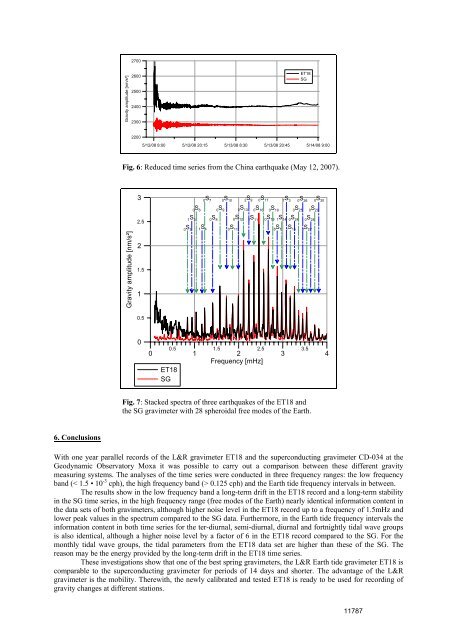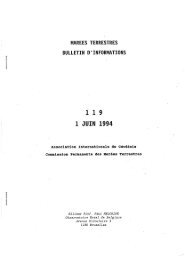marees terrestres bulletin d'informations - Université de la Polynésie ...
marees terrestres bulletin d'informations - Université de la Polynésie ...
marees terrestres bulletin d'informations - Université de la Polynésie ...
Create successful ePaper yourself
Turn your PDF publications into a flip-book with our unique Google optimized e-Paper software.
2700<br />
Gravity amplitu<strong>de</strong> [nm/s²]<br />
2600<br />
2500<br />
2400<br />
2300<br />
ET18<br />
SG<br />
2200<br />
5/12/08 8:00 5/12/08 20:15 5/13/08 8:30 5/13/08 20:45 5/14/08 9:00<br />
Fig. 6: Reduced time series from the China earthquake (May 12, 2007).<br />
3<br />
0S 7<br />
0S 8<br />
0S 9<br />
0S 10<br />
2S 9<br />
0S 17<br />
7S 3<br />
0S 26<br />
0S 30<br />
2.5<br />
0S 6<br />
1S 3<br />
1S 4<br />
0S 12<br />
1S 11<br />
0S 18 1S 14 0S 24<br />
0S 28<br />
Gravity amplitu<strong>de</strong> [nm/s²]<br />
2<br />
1.5<br />
1<br />
0S 5<br />
0S 11<br />
8S 1<br />
1S 15<br />
0S 27<br />
0S 13<br />
0S 16<br />
0S 19<br />
0S 25<br />
0S 29<br />
0.5<br />
0<br />
0<br />
0.5 1.5 2.5 3.5<br />
1 2 3 4<br />
Frequency [mHz]<br />
ET18<br />
SG<br />
Fig. 7: Stacked spectra of three earthquakes of the ET18 and<br />
the SG gravimeter with 28 spheroidal free mo<strong>de</strong>s of the Earth.<br />
6. Conclusions<br />
With one year parallel records of the L&R gravimeter ET18 and the superconducting gravimeter CD-034 at the<br />
Geodynamic Observatory Moxa it was possible to carry out a comparison between these different gravity<br />
measuring systems. The analyses of the time series were conducted in three frequency ranges: the low frequency<br />
band (< 1.5 • 10 -3 cph), the high frequency band (> 0.125 cph) and the Earth ti<strong>de</strong> frequency intervals in between.<br />
The results show in the low frequency band a long-term drift in the ET18 record and a long-term stability<br />
in the SG time series, in the high frequency range (free mo<strong>de</strong>s of the Earth) nearly i<strong>de</strong>ntical information content in<br />
the data sets of both gravimeters, although higher noise level in the ET18 record up to a frequency of 1.5mHz and<br />
lower peak values in the spectrum compared to the SG data. Furthermore, in the Earth ti<strong>de</strong> frequency intervals the<br />
information content in both time series for the ter-diurnal, semi-diurnal, diurnal and fortnightly tidal wave groups<br />
is also i<strong>de</strong>ntical, although a higher noise level by a factor of 6 in the ET18 record compared to the SG. For the<br />
monthly tidal wave groups, the tidal parameters from the ET18 data set are higher than these of the SG. The<br />
reason may be the energy provi<strong>de</strong>d by the long-term drift in the ET18 time series.<br />
These investigations show that one of the best spring gravimeters, the L&R Earth ti<strong>de</strong> gravimeter ET18 is<br />
comparable to the superconducting gravimeter for periods of 14 days and shorter. The advantage of the L&R<br />
gravimeter is the mobility. Therewith, the newly calibrated and tested ET18 is ready to be used for recording of<br />
gravity changes at different stations.



